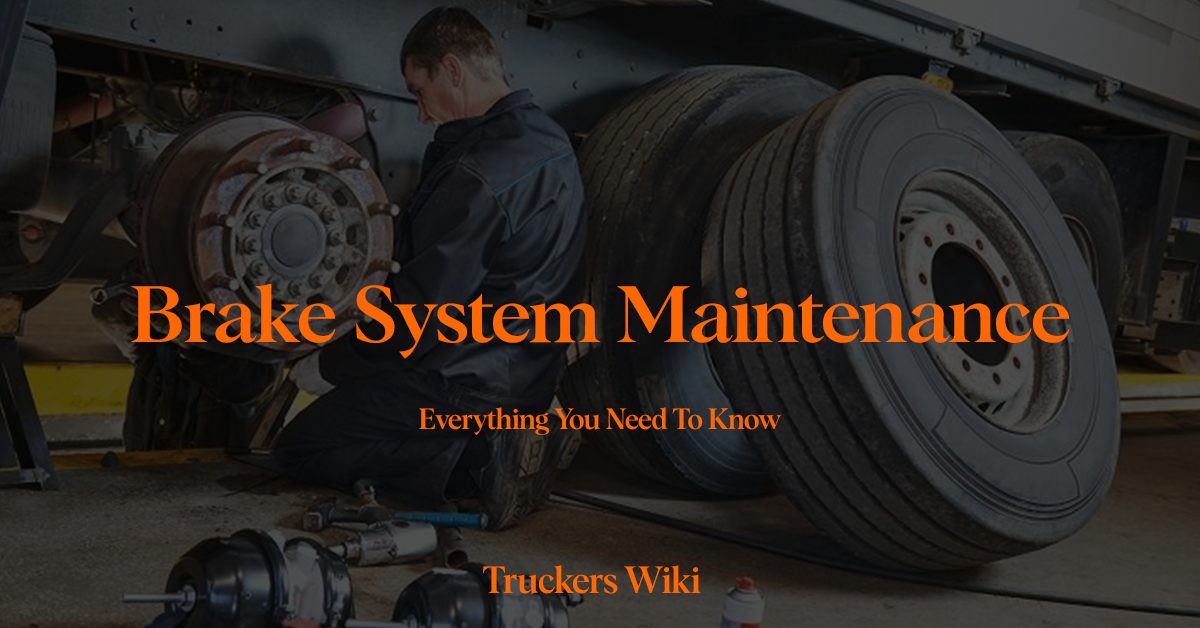
Table of Contents
Different Semi Truck Brake Types
Commercial trucks may have different brake types, including drum brakes, disc brakes, and air brakes. Drum brakes utilize a rotating drum and shoes, while disc brakes use rotors and pads. Air brakes, often found in heavy-duty trucks, use compressed air to apply the brakes. Understanding these types and their unique maintenance needs is important for proper safety.
Introduction to Brake System Components
The brake system is composed of various components, including brake pads, rotors, fluid, lines, master cylinders, and more. Familiarizing oneself with these parts and their function will help in proper inspection and maintenance.
Inspection and Maintenance Overview
Regular Inspection Intervals
Routine inspection of the brake system is necessary to identify wear and tear early. It can vary depending on the truck’s usage, load, and manufacturer recommendations. Check your brakes at least every three months.
Professional vs. Self-Inspection
Some aspects of brake system maintenance can be handled by the driver or operator, such as visual inspections. However, certain tasks might require a professional technician with specialized tools and knowledge. Balancing these two approaches ensures thorough care without overlooking critical issues.
Maintenance Records and Compliance with Regulations
Keeping detailed records of all inspections and maintenance performed is essential for legal compliance and warranty considerations. Accurate records can also assist in diagnosing future problems and provide evidence of responsible vehicle care.
Brake System Components Maintenance
Brake Pads and Rotors
Brake pads and rotors are key components that need regular inspection and possible replacement. Checking for wear, cracks, or uneven surfaces is vital. For disc brakes, measuring the thickness of pads and rotors helps ensure they meet the manufacturer’s minimum specifications.
Brake Fluid and Hydraulic System
The hydraulic system, using brake fluid, transmits force from the pedal to the brakes. Regularly checking fluid levels and inspecting for leaks is crucial. Fluid quality can degrade over time, so periodic flushing and replacement might be necessary according to the manufacturer’s guidelines.
Air Brake System
In trucks with air brakes, maintaining proper air pressure and checking all components, including the compressor, valves, and lines, is vital. Any moisture in the system must be drained, and leaks should be promptly repaired. Regular testing of emergency and parking brakes ensures full functionality.
Anti-lock Braking System (ABS)
Modern commercial trucks usually come with ABS to prevent wheel lockup. Regular inspection of sensors, wiring, and other components helps ensure that this safety feature operates correctly. Diagnostic tools may be used to identify and resolve any error codes.
NHTSA research article on The Effectiveness of ABS in Heavy Truck Tractors and Trailers (it is a .DOC report)
Safety Considerations
Tools and Safety Equipment
Proper maintenance of the brake system requires specific tools and safety equipment. Following safety guidelines and using the right tools prevents accidents during maintenance and ensures accurate and effective work.
Environmental Considerations
Proper disposal of brake fluid, worn pads, and other components must comply with environmental regulations. Being aware of and following these rules protects the environment and avoids potential legal issues.
Training and Certification
Professional technicians working on commercial truck brake systems should have the necessary training and certification. For fleet operators or individual truck owners, providing ongoing training ensures that maintenance staff is up-to-date with the latest techniques and regulations.
Brake Maintenance Scheduling
Regular Inspection Intervals
Scheduling regular inspections of the brake system is essential. This includes daily pre-trip checks for visible issues, periodic detailed inspections based on mileage or hours of operation, and comprehensive annual inspections as required by regulations.
Record Keeping
Maintaining accurate records of all brake maintenance activities helps in tracking the health of the brake system and ensures compliance with legal requirements. These records include dates, details of inspections, repairs, parts replaced, technician names, and other relevant information.
Seasonal Considerations
In regions experiencing significant seasonal weather changes, brake system maintenance may need to be adjusted. For example, winter maintenance may include special attention to the air brake system to prevent moisture freezing.
Emergency Brake Repairs
Recognizing Signs of Failure
Training drivers and technicians to recognize the early signs of brake failure helps in taking timely action. Unusual noises, vibrations, or changes in braking performance are often early warning signs.
On-the-Road Repairs
Having a plan and necessary tools for emergency on-the-road repairs can prevent extended downtime. Basic tools and essential spare parts should be part of every truck’s emergency kit.
Towing and Professional Assistance
In some cases, brake issues will require professional repair services. Having a plan for towing and a list of trusted repair shops ensures that emergency situations are handled smoothly.
Conclusion
Importance of Proper Brake Maintenance
Brake maintenance is not just a regulatory requirement; it’s a critical safety issue for both the driver and others on the road. Proper maintenance ensures optimal performance and extends the lifespan of the brake system.
Commitment to Continuous Learning
With the continuous evolution of brake technology, staying updated with the latest tools, techniques, and regulations is vital.
FMCSA article about brake systems on Semi Trucks.
CarolinaCATs 5 Tips to keep your brakes running properly.
Learn more about Diesel Engine + Maintenance here.
Learn about the different types of Semi Truck Tires here.
Learn about Pre-Trip Vehicle inspection here.
Here is a Preventive Truck Maintenance a Comprehensive Guide.
Checking Brakes Before Going Downhill video by Todays Trucking
Listen to The Article Here
FAQ
Usual lifespan of a semi truck brakes is 250,000 miles, but depending on the usage, weather conditions and other factors, brakes can last up to 300,000 miles.
Replacing brakes on a semi truck can cost you anywhere from $200 to $500 per axle, while drums go for $100 to $225.
If you are looking to save money get new brakes done when you install new drive tires.
Audio Article Brake System Maintenance Everything you need to know
Last modified: February 24, 2024

